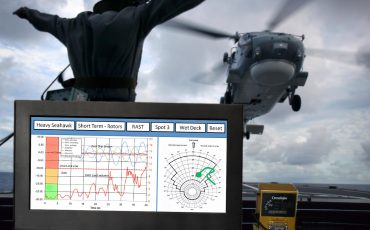Real Time Simulation Technology
Our real-time software can predict whether it is safe for a helicopter to land / takeoff, use a particular restraint system, and determine whether it is safe to use a particular lashing scheme. The capability provides the safest most capable solution to embarked helicopter operations in hazardous conditions. The innovative high-fidelity code offers the optimum solution and is unparalleled in capability.
Dynamic ship limits
When capability and safety matter
The system uses actual 6-DOF ship motion input and wind sensor data to estimate limit proximity in real time. Rather then relying on pure static roll and pitch limits the system provides an accurate indication of actually how close the helicopter is to exceeding a particular limit like sliding or lashing failure.
Maximum Capability, Safety and Cost Effectiveness
Both ship and helicopter operating capability can be significantly enhanced in certain conditions. The inertial ship motion unit sensor input monitors all six ship degrees of freedom (roll, pitch, yaw, heave, ….), rates & accelerations (angular, translational) and accounts for ship ballast, list, trim and manoeuvring. It also incorporates a wind anemometer input. This means that you are no longer relying on worst case pitch and roll limits associated a worst-case ship ballast condition, ship speed and relative wave heading. The output reflects the impact of the real conditions directly by simulating the response of the helicopter in real time. No other software does this so accurately.
Real time simulation
Real time simulation enables accurate prediction of sliding/toppling limits and lashed and restraint system limits and is able to display limit progression over time. Whilst ship motion is largely unpredictable at times it does in the right prediction offer improved situational awareness.
Real time tuning & validation
The real time simulation capability with ship motion input enables actual load and displacement sensor data to be simultaneously overlaid with simulated response data. This therefore provides an immediate vivid indication of whether the simulation software is valid and of the required fidelity. Better still the helicopter simulation parameters can be tuned in real time to drive the helicopter model into a correlated state. Within a week, if parameterised correctly the operator can tune the model knowing that any future simulation results produced are valid. With all the degrees of freedom associated with the ship and the helicopter this ability is without a doubt the most cost effective and safe way to validate the code. This capability was demonstrated with the NZ navy with NH90 to great affect.
